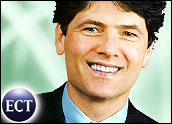
A couple of weeks ago, which corresponds with my absence from this space last week, I was on vacation trying hard to not think about work or CRM, but something hit me while watching a ballgame. I don’t have a lot of current statistical data to back me up, so this might even be right.
It seems like batting averages are a tad on the low side for many ball players this year. People who were traditionally hitting above .300 are now below — with some notable exceptions. There are still some players hitting the ball a ton, like Derek Lee, Miguel Cabrera and Johnny Damon. But others who should be up there are conspicuously absent, like Manny Ramirez, who leads the majors in RBIs, but who at .275 is also batting well below his career .313 average.
Now, I know that one popular explanation is the whole steroids thing, and with the game getting tough on juice people who may have used enhancements in the past, they might be feeling the effects of withdrawal. But I am not buying it. I think there’s more to it.
The 30-Year Itch
I recall in Ken Burns’ excellent series “Baseball” that he documented eras when pitchers had the upper hand and other eras when hitters did. Like a lot of things in American public life, it seems there is a roughly 30-year cycle at work. Recall the Yankees of the 1920s who were so ferocious they were referred to as “Murderer’s Row” and the early 1960s Yankees who had hitters like Roger Maris and Mickey Mantle.
Yet by 1961 — the very year Maris eclipsed Ruth as the single-season home run king with 61 — it was nearly over. Ted Williams retired in 1960 and his replacement in left field for the Red Sox, Carl Yastremski (another Hall of Famer), won the Triple Crown in ’67 with a .326 average and won the American League batting title the next season with just a .301 average — the lowest average for a single-season batting champ in the history of the game. That was also the era of dominating pitchers like Bob Gibson who in 1968 pitched in 34 games and sported a gaudy 1.12 earned run average. The late 1960s were definitely a pitcher’s time.
Generally, a pitcher’s era is dominated by “small ball” — manufacturing runs by bunting to get on base, or running up the pitch count and once on base stealing second to get into scoring position. No less a hitter than Williams preached the idea of looking for a good pitch to hit and, above all, patience.
So my question is whether the years from the mid-1990s to the mid-2000s were another hitter’s era, regardless of steroid use. Aside from Roger Clemens, Greg Maddux and a handful of others, there aren’t a lot of pitchers from this era headed for Cooperstown. By the same token, we saw a lot of great hitting over the last decade or so. So does the 30-ish year cycle hold? I dunno. But my point is that in baseball, we might see a useful metaphor for what is going on in the tech sector.
Baseball as a Metaphor, What a Concept!
We hear a lot of talk about there not being a new, new thing to propel the industry, and that sure seems true. The era that ended with the dot-com bubble bursting was one in which selling was really fun. It was a sales person’s dream. Organizations couldn’t get enough technology for ERP, Y2K, CRM, wireless devices, networks and telecommunications. You could call it a “hitter’s” era. But we may have crossed over into a “pitcher’s” era now where growth is more organic and organizations have to pay attention to the details of marketing and customer service to maintain their market share and show profit and growth.
If that’s true, we should see signs of changing demand in CRM — and those signs are there if you know where to look. For example, marketing as a strategic tool is becoming a hot topic and so is the idea of using the call and contact center more effectively for cross selling and upselling.
Other indications that point to this trend include robust profits in many corporate sectors but lagging employment gains — which can be explained if companies are selling more of what they have to customers who are already in the stable. Metrics for customer loyalty, when they come out, will be a telltale sign to either back up this kind of thinking or disprove it.
At the end of the day, though, we all still have to do our jobs — organizations still need to sell and baseball teams need to score runs. But understanding the cyclicality inherent in our surroundings might help us adjust to times when we can swing for the fences and those times when we need to play small ball.
Denis Pombriant is a well known thought leader in CRM and the founder and managing principal of the Beagle Research Group, a CRM market research firm and consultancy. Pombriant’s latest report, CRM WizKids: Taking CRM to the Next Level, identifies emerging CRM leaders and their innovative technologies. In 2003, CRM Magazine named Pombriant one of the most influential executives in the CRM industry. Pombriant is currently working on a book to be published next year. He can be reached at [email protected]






















































